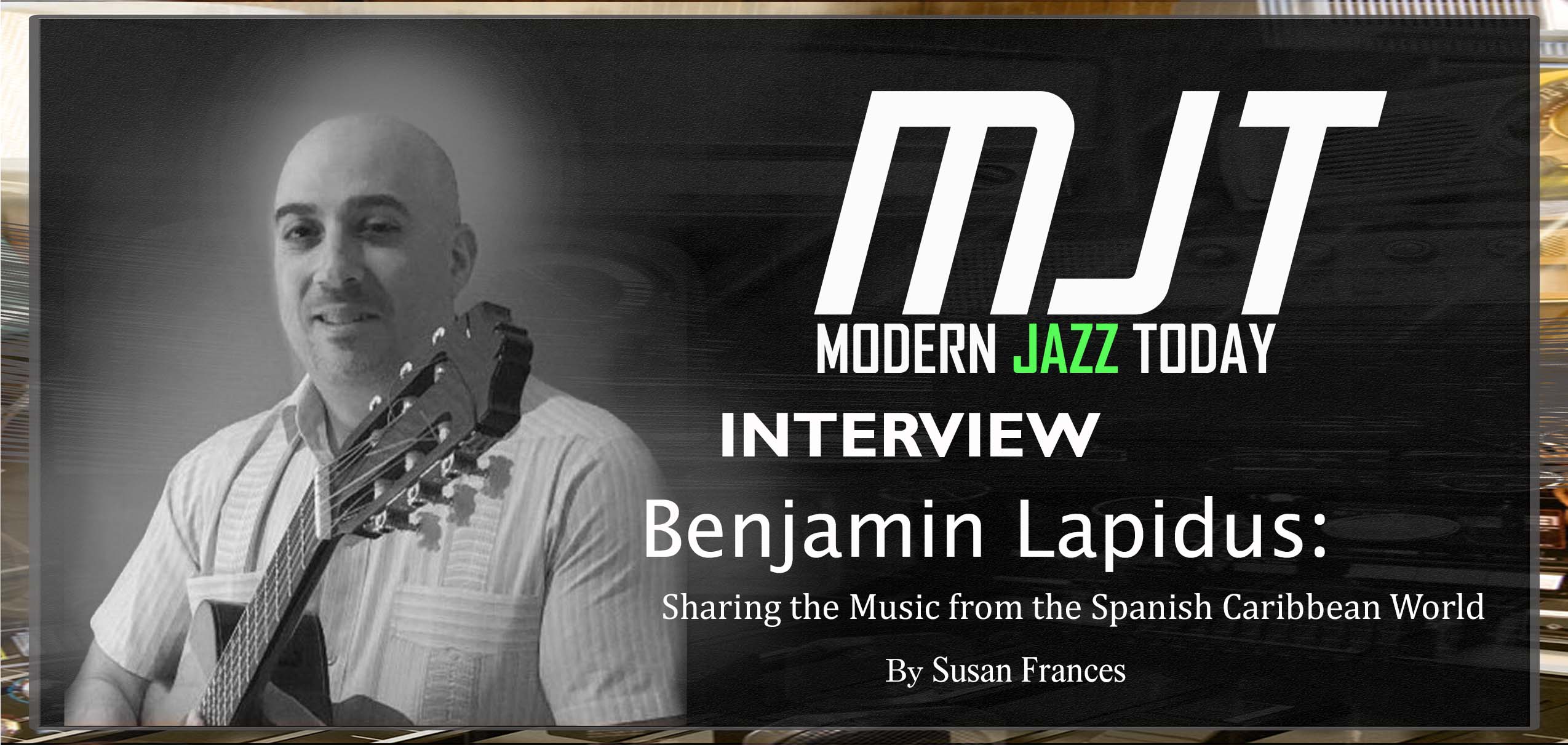Benjamin Lapidus: Sharing the Music from the Spanish Caribbean World
by Susan Frances

What audiences discover in Lapidus’s music is harmonic forms like orisha music, Afrocuban sacred music, rezos or prayers, Ochosi blues, Cuban guaracha, son cubano, changüí, and tumbao or Cuban swing, to name a few. Lapidus opens audiences’ minds to the rich and multi-faceted world of Spanish Caribbean breeds.
Born in Hershey, Pennsylvania, in 1972, Benjamin Lapidus’s parents are first-generation Brooklynites. According to his biography found on his website, “The family moved almost 15 times before returning to New York City when Lapidus was 14.”
He recalls, “My father had a guitar in the house, and I had asked to study guitar at age 8 after I started piano lessons at the age of 6. I was attracted to it simply because it wasn’t a piano, which was what my father, grandmother, and sister played.”
He shares, “I have been composing since my teenage years and never stopped. I became a bandleader to work on my own musical concepts, arrangements, and ideas. It was also an opportunity to improvise more than in the traditional Latin music dance contexts that I had been working in.”
“My first album ¿Quién tiene ritmo? came out in 1998,” he provides, “and I think there are some things that I can’t believe I could pull off and play over the last 25 years and 8 previous albums because it’s hard to keep everything under your fingers all the time. But I think I definitely have my own sound as a guitarist, a tres player, a Warr guitarist (tapping/touchstyle guitar), and as a composer and vocalist.”
Lapidus’s exploration of the various styles of Latin jazz led him to discover various types of instruments to achieve the sound he desired. The Warr guitar is one discovery he continues to use and plays on his 2023 release Blues for Ochún, his ninth recording as a leader.
He explains how his connection to the Warr guitar began, “I started playing the Warr guitar in 2002 after trying it out in Frank Jolliffe’s house in Paterson, New Jersey. Frank had switched from the Chapman stick to Warr guitar, and I liked the way that it played and sounded.”

“The Warr guitar is very different from any other guitar,” he purports, “because it has 6 bass strings (tuned in 5ths) and 6 guitar strings (tuned in fourths) that are tapped. Think Stanley Jordan. Plus, each group of strings is tuned differently. It’s a lot of mental gymnastics.”
Athletic by nature, the Warr guitar is a good fit for Lapidus, who describes himself as “I am an avid runner with 9 marathons under my belt and many other half marathons and shorter races. I actually wrote a few songs on this album, either running or in my car.”

The recording opens with the title track and “3 for Ochún.” Lapidus offers insight into why the two tracks are paired together, making a suite. “‘Blues for Ochún’ and ‘3 for Ochún’ are supposed to be heard as one long track, and that’s how they were recorded. The end of ‘Blues for Ochún’ goes from D minor to C Major, which is where ‘3 for Ochún’ picks up. It’s all one long piece for Ochún using a ritual setting for inspiration.”
Ochún or orisha is a Yoruba ancestor/spirit and the patron saint La Virgin de la Caridad del of Cuba. Lapidus visited the shrine of Ochún in 1997, and 26 years later, he has created a musical offering to celebrate his long relationship with the island, its people, music, and history.
His drummer Mauricio Herrera plays a significant role in the arrangement, whom he commends, “Mauricio is a complete percussionist who plays all hand drums and drum set. He is also a well-known performer of Afrocuban sacred drumming. We had been talking about this for some time and had rehearsed the transitions between each section,”
“On this track,” Lapidus cites about “3 for Ochún” and highlights, “he is heard playing the 3 batá drums by himself all at once, which is a specialty, and also quite challenging since they usually require three performers. Mauricio also plays congas and chekere on this track.”
“The idea behind the arrangement,” he illuminates, “was to mix the organ with orisha music and have the organ lead the rezos (prayers), then Jadele [McPherson] would take over and improvise in the usual manner as if there was no organ.”
Vocalist Jadele McPherson also has a significant role in the suite, as her chanting ruminations enrich the spiritual mist in the atmosphere. Lapidus reveals, “I had seen Jadele McPherson perform live, and we have some mutual friends. I wanted her voice to sing for Ochún because she has an incredible voice and because she is an Afrocuban sacred music singer who is deep in the tradition. I knew that she could really sing anything and that she would be open to what I was trying to do with the music. She is awesome.”
Also featured on the recording Blues for Ochún is Lapidus’s tweaking of Charlie Parker’s gem “Donna Lee.” He touts about the track, “It’s one of the greatest jazz compositions of all time and a rite of passage for many aspiring musicians. I happened to get into Jaco Pastorius’ version because it was popular when I was a teenager. This was my way of paying homage to Jaco and also playing the piece with tumbao (Cuban swing). Jaco’s amazing version is a duo with Don Alias, and my version is a duo with Mauricio Herrera but with added layers of percussion.”
The recording includes performances by Jorges Bringas on bass, Paul Carlon on flute, tenor and baritone saxophones, Manuel Alejandro Carro on congas, bongo, guagua, quinto, timbales, maracas, campana, and güiro, Ray “Chino” Diaz on conga, güira, and tambora, Willie Martinez on drums, and a bongo solo by Hector Torres on the track “Cachita.” The instruments that Lapidus employs on the recording include tools that are inherent to the Spanish Caribbean culture such as batá, chekere, bongo, campana, cajón, güiro, maracas, congas, monte, guayo, güira, guagua, quinto, timbales, and tambora, giving the listener a genuine ear full of exotic and melodic sounds.
“I loved recording with all of the musicians,” he vows, “and hearing what they each added to the music.”
He also gives special recognition to his engineers and mixers, adding, “I also loved working in the studio with Danny Lapidus (no relation) and Joel Hamburger. It was challenging getting a good even sound with the instrumentation, but once we did, we also changed things up.”

One hurdle that Lapidus confronted during the recording process was being sidetracked by the pandemic in 2020, as he determines that the most difficult part about the endeavor was “Probably when Covid was at its height. The music was ready to go in 2019, but then studio dates were getting canceled in 2020-2021, so the recording had to be done in 2022.”
Looking back, he muses, “I think I am exposed to a lot of music, but I am always interested in learning new music, history, techniques, etc., so that definitely can come up in songwriting or arranging. I always look to the past as a way to figure out what I am doing now.”
“I have tried a lot of different things,” he asserts, “and have revisited some of them as I move forward. I really don’t listen to my previous albums at all, but I play the music I have written over these 25 years on gigs, and the compositions are still fun to play.”

“This record is no different,” he declares. “There is definite growth and change, new instruments, new music, a couple of old songs with new versions, but the sound, concept, and style is mine, and it has expanded since I started on this path. There is more to learn, write, grow, and definitely more music to make. To me, that’s growth.”
Lapidus not only has nine albums now as a leader to his credit, but he also has the book he authored, New York and the International Sound of Latin Music. He deems, “It started as conversations with my elders, musicians who took the time, both on and off the bandstand, to share their insights, memories, and the history of the music. From there, I just ran with following up with formal interviews, archival research, and transcription analysis.”
“All told,” he surmises, “it took 8 years from start to finish. I learned a ton.”

Identifying the roots of Latin, Spanish, Caribbean, and Afro-Cuban jazz blends has given Lapidus a broader view of music and a greater reservoir from which to make music. What Lapidus offers to audiences is Latin styles that are steep in history, though contemporary generations will find the music to be new to their ears. His music opens audiences’ minds to the rich and multi-faceted world of Spanish Caribbean breeds and their bond to the human soul.
About Susan Frances:






No Comments